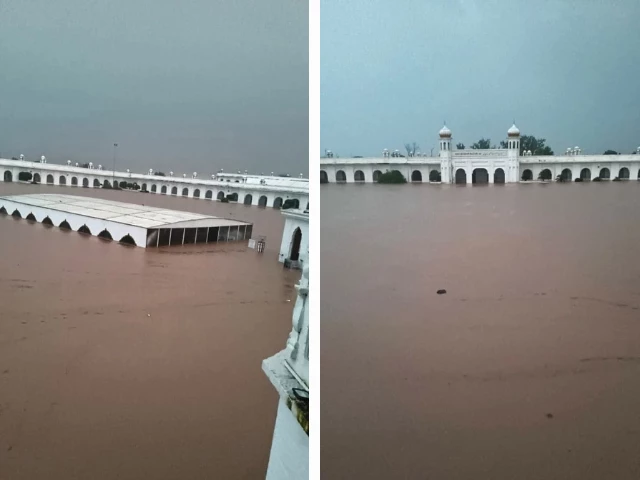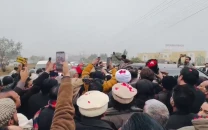Kartarpur Gurdwara to reopen soon following restoration work
Floodwater had submerged parts of the gurdwara up to 10 to 12 feet

The Gurdwara Darbar Sahib Kartarpur will reopen for pilgrims once repair work is completed, likely within three to four days, subject to weather conditions and the Ravi River’s flow, government sources said.
Cleaning and restoration are underway at the Sikh holy site after floodwaters receded, but the process has been slowed by power outages. Officials said heavy rainfall on Friday further hampered the efforts.
Additional Secretary Shrines, Evacuee Trust Property Board (ETPB), Saifullah Khokhar, said the gurdwara was inundated after embankments along the Ravi River and Nullah Bae breached. He noted that repair work on the embankments will only begin once water levels fall.
Floodwater had submerged parts of the gurdwara up to 10 to 12 feet, which were later cleared with the help of rescue teams, the district administration, and army personnel. The main courtyard, inner sections, and Darshan Deori have since been cleaned, while special arrangements were made to protect the Guru Granth Sahib.
Read: Punjab holds its breath as rivers surge
Yesterday, Field Marshal Chief of Army Staff (COAS) Asim Munir, also visited the site during relief efforts.
#ISPR
— Pakistan Armed Forces News 🇵🇰 (@PakistanFauj) August 29, 2025
Rawalpindi, 29 August, 2025
Field Marshal Syed Asim Munir, NI (M), HJ, Chief of Army Staff (#COAS) #Pakistan Army, visited flood affected areas of #Punjab including Sialkot Sector, Shakargarh, Narowal and Kartarpur.
The visit was aimed to review the flood situation and… pic.twitter.com/5NuQGFBhKL
During his interaction with the Sikh community, the COAS assured that all religious sites damaged by the floods — including Gurdwara Darbar Sahib Kartarpur — would be fully restored to their original condition on priority, according to a statement from the Inter-Services Public Relations (ISPR).
COAS also undertook an aerial survey of Darbar Sahib Kartarpur to assess the extent of damage.
For dewatering, pumping machines and drainage channels were deployed, though manual cleaning remained necessary due to electricity disruptions.
Officials said long-term measures will be implemented to prevent future flooding, including strengthening embankments, upgrading drainage systems, and installing improved early-warning systems.
The government and military leadership have reiterated their commitment to ensuring maximum protection of all religious sites, including Gurdwara Sri Darbar Sahib.
Read more: Sikh religious sites at risk in Pakistan, India as Ravi River overflows
Punjab floods
Earlier this week on Wednesday, floodwaters from the Ravi River surged into Gurdwara Darbar Sahib in Kartarpur, submerging its courtyard and halting pilgrimage at one of Sikhism’s holiest sites.
Visuals from the field showed the shrine’s marble steps and courtyard completely inundated, as floodwater swept into the complex overnight. Around 200 to 300 pilgrims were stranded in Kartarpur Corridor, with the armed forces called in to carry out rescue operations.
Officials from the Evacuee Trust Property Board confirmed that floodwater had seeped into the compound, reaching nearly three feet in some areas and forcing pilgrimages to a sudden halt.
But the threat is not confined to Pakistan. Across the border in India’s Gurdaspur district of Punjab, the historic town of Dera Baba Nanak — home to another sacred Sikh shrine — is in reportedly precarious conditions, with rising river levels fueled by continuous heavy rainfall in the upper catchment areas, particularly Himachal Pradesh and Indian Illegally Occupied Jammu and Kashmir (IIOJK).
The town holds immense religious importance. It is located directly opposite Kartarpur and linked to Pakistan by the landmark visa-free Kartarpur Corridor. Since 2019, the corridor allows thousands of Indian pilgrims to visit the shrine in Narowal, where Baba Guru Nanak, the founder of Sikhism, spent his final days.




















COMMENTS
Comments are moderated and generally will be posted if they are on-topic and not abusive.
For more information, please see our Comments FAQ